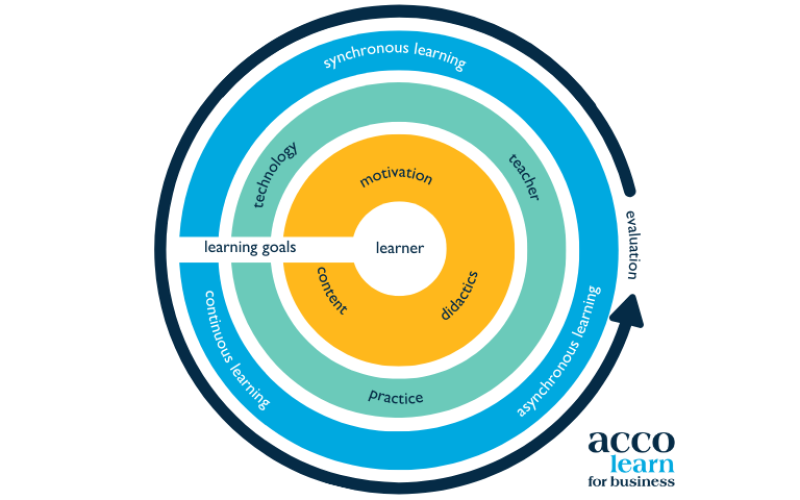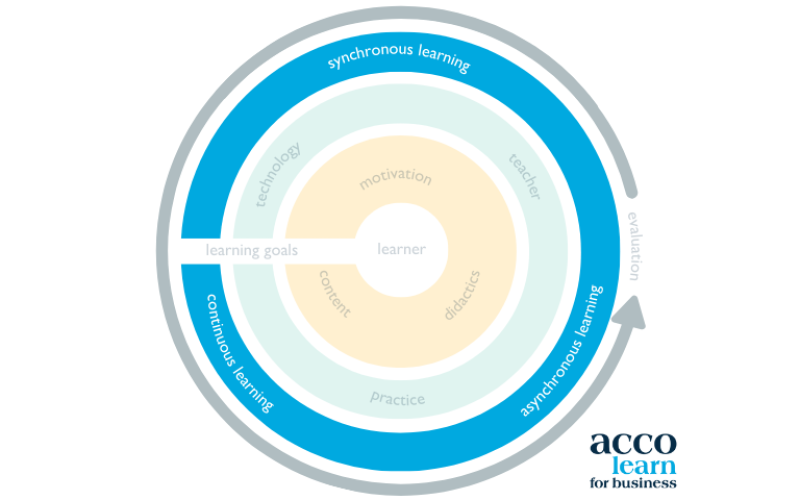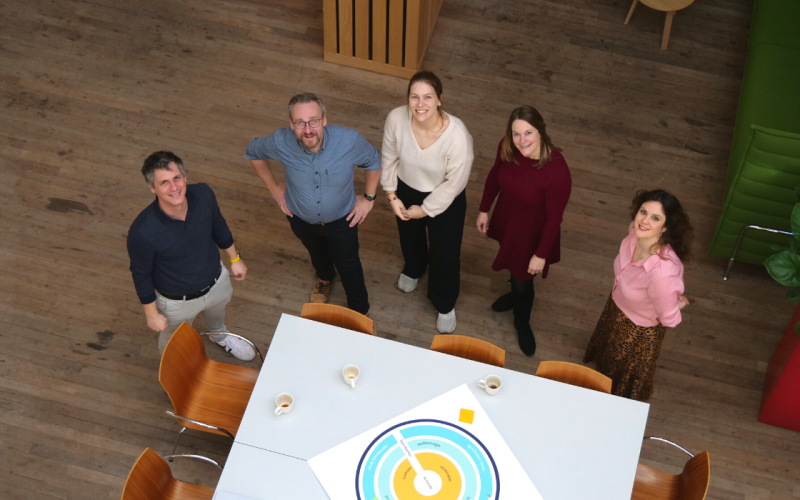
Centre: the learner
Everyone learns differently
Learning is a personal process. Therefore, a successful learning solution takes into account the learning audience. A training course for a sales team needs to be mobile, for example, while compulsory training sessions often require an extra dose of fun. Differences in existing knowledge within a group don’t have to be a problem if everyone can follow a personal learning path. That’s why at Acco Learn for Business we always start with the learner. Once we understand your learners’ needs, we can build the learning solution around them.

Layer 1: building blocks
Didactics, motivation & content
Efficient learning requires a mix of high-quality content, proven didactics and a high level of motivation. For Acco Learn for Business, those are fundamental building blocks of any learning experience – and so they are placed in the first layer of our model, around the learner.
Didactics
We help your audience to learn efficiently through applying evidence-based didactic principles. That includes adaptive learning paths, real-life examples and tailored support (or ‘scaffolding’). We also monitor the learning process using learning analytics. That is how we address any gaps and areas for improvement during and after training courses to achieve even better learning outcomes.
Motivation
People who are motivated learn faster and better. That’s why we integrate aspects that will encourage your audience. We focus on autonomy, alternate strategic teaching moments with active work formats, celebrate success stories and integrate rewards. In short, we do all we can to inspire an enthusiasm to learn among your audience.
Content
Targeted, bite-sized content makes your training attractive and varied. Our domain-specific content experts edit your existing material, create new content and bring the two together. They do this in every possible format: clips, interactive exercises, infographics, games, photos, podcasts, etc.

Layer 2: catalysts
Teacher, technology & practice
The teacher is always the hub in the learning process. Support teachers with the right technology, add real-world learning opportunities, and you’ll take the learning experience to new heights.
Teacher
The teacher has a crucial role in guiding course participants. Teachers are also the true content experts. That’s why we always consult them extensively, and try to inspire and motivate them to build the ideal learning journey with us.
Technology
By ‘technology’, we mean all the tools that contribute to good learning: from paper to a convenient learning platform. Thanks to extensive knowledge of edtech products and our learning platform Sofia, we integrate the right technology at the right time for your audience.
Practice
You need to be able to apply what you’ve learned in real life. We go from know-how to show-how by placing course participants in real-life situations, both virtually (via virtual or augmented reality) and in person. This is how we really apply learning by doing.

Layer 3: learning moments
Synchronous, asynchronous & continuous learning
The above elements lead to a learning journey that combines synchronous and asynchronous learning moments to create a single blended learning experience. To prevent lesson material from being forgotten, we incorporate repetition through recurring (micro) learning moments.
Synchronous learning
Whether it’s in the same room or via a webcam, interaction with teachers or with peers makes learning more enjoyable and more effective. Synchronous learning moments can focus on learning new material, or on practising material that was covered during an asynchronous learning moment (known as the ‘flipped classroom’ principle).
Asynchronous learning
There’s nothing like working at your own speed, time and place, and according to your own learning needs. Asynchronous learning might involve processing learned material (with fun, varied exercises) or acquiring new knowledge (e.g. by watching short clips), whether or not using the flipped classroom principle.
Continuous learning
Unfortunately, we tend to forget what we learn. That’s why it’s important to frequently refresh our learnings. That could be via a weekly email with exercises or WhatsApp messages with reminders of important material. We offer multiple options.

Layer 4:
Learning goals and evaluation
The above elements lead to a learning journey that combines synchronous and asynchronous learning moments to create a single blended learning experience. To prevent lesson material from being forgotten, we incorporate repetition through recurring (micro) learning moments.
Learning goals
Effectively set learning goals reflect the knowledge, skills and attitudes that are required of the learner. They provide guidance and give insights into what the learner must have acquired by the end of the learning path. We help formulate your learning goals in a fine-tuned and quantifiable way, so that they become a means for identifying the way ahead for further growth and development.
Evaluation
Targeted evaluation will enable both the learner and the teacher to gain an insight into the learning progress being made. Formative evaluation helps identify exactly what support is needed in order to achieve the set learning goals. A summative evaluation allows you to assess whether the learner has acquired adequate knowledge, skills or the right attitude, for example, with a view to accreditation or certification.
Ask our learning consultants
Do you have a question about learning solutions for businesses? We are happy to help!

